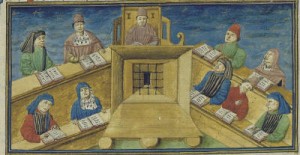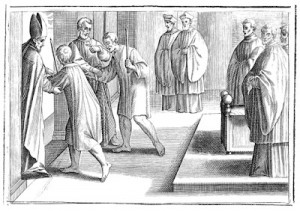Prescinding from the larger question as to what extent the present ordinary process for adjudicating marriage nullity cases is in need of reform, there can be little doubt that the new canons introduced by Mitis iudex (set to come into force on 8 December) will invariably lend themselves to abuse in the administration of justice.
In this post, we consider the implications of the subtle yet powerful “et cetera” which appears at the end of Article 14 §1 of the Ratio procedendi (the official explanation which accompanied the new norms). Article 14 §1 sets forth the various types of cases which qualify to be instructed according to the processus brevior or so-called “fast track” nullity process:
Among the circumstances that may allow the handling of the case of nullity of marriage by means of the shorter process according to cann. 1683-1687, includes for example: that lack of faith that can generate simulation of consent or error that touches the will, the brevity of conjugal cohabitation, a procured abortion to prevent procreation, the stubborn act of remaining in an affair at the time of the wedding or in the time following it, the fraudulent hiding of sterility or an incurable disease, or of children born from a previous relationship, or hiding the cause of marriage completely extraneous to married life, or the unexpected pregnancy of the woman, physical violence inflicted to bring about consent, the lack of use of reason proved by medical documents, etc.
Not unlike certain ambiguities and vague expressions which found their way into the official documents of Vatican II, the “etc.” in Article 14 §1 will, I contend, be among the most potentially abused targets of heterodox interpretations found in the new norms. This abuse will be made possible by the vast reservoir of administrative discretion granted to diocesan bishops under the reformed law. While it is true that certain basic requirements must be met in order for a case to be heard according to the processus brevior, it is equally true that these requirements are not very difficult to satisfy under the new norms. The threshold requirements for a case to qualify for being heard according to the shorter process are as follows:
- The petition [for nullity] must be proposed by both parties or proposed by one party with the consent of the other party;
- The nullity of the marriage must be manifest;
- All the facts which demonstrate that the marriage is manifestly null must be readily available.
Monsignor Pio Vito Pinto, Dean of the Apostolic Tribunal of the Roman Rota, recently clarified that the first requirement will be sufficed with “the agreement of the parties (or at least the declared absence from the process of the respondent in the process”. (“Procedural reform pertaining to declarations of marriage nullity,” in L’Osservatore Romano, English Edition, 11 September 2015, n. 37, 4) When one considers these words of Msgr. Pinto in light of the fact that it is quite common (at least in North America) for a respondent to be declared absent from a process simply on the basis of his or her failure to respond to a single letter of citation (typically sent via certified mail) in which the tribunal requests the respondent to indicate whether he or she intends to participate in the process. Thus, the first threshold requirement of the shorter process, namely the consent of the other party, will frequently be satisfied when the respondent fails to respond to the tribunal’s letter of citation. Yet, if the Church is now prepared to interpret the silence of a respondent as evidence of his or her consent to a petition for nullity, it will have effectively turned a blind eye to that centuries old and venerable doctrine of canon law which holds that silence is to be interpreted “in the favor of the one who is silent – not to his detriment, whenever circumstances or conjecture raise doubts as to the precise meaning to be ascribed to that silence.” (A. Reiffenstuel, Tractatus de regulis iuris, Craetz et Summer: Monachii et Ingolstadtii, 1776, p. 117, n. 18.) While such a doctrine is not of divine or natural law, the thought of abandoning a well-established principle of canon law, presumably for the sake of expediency, is unsettling.
Regarding the second requirement that the nullity of the marriage must be “manifest”, I would call the attention of the readership to the disparity which exists among individual bishops in their interpretation of “manifesto” in the context of the discipline of canon 915. The lack of uniformity in applying the Church’s discipline in this regard is well known. Are we to believe that there will be anything close to a consensus among bishops as to what constitutes “manifest” nullity? Even granting that a body of jurisprudence will eventually develop around this and other questions concerning the elements required to instruct a case according to the shorter process, the fact is that many bishops will continue to proceed according to the precedents they themselves have established within their own territories. The final requirement that “all the facts which demonstrate that the marriage is manifestly null must be readily available” will likewise admit of varying interpretations at the local level.
If one accepts that the present crisis in the Church is a crisis of bishops (as this author does), it would be rather naïve to believe that the processus brevior will be something exceptional or rare in contemporary tribunal practice. Indeed, if recent trends in canonical penal procedures provide any indication as to what we can expect to see in the near future (the past two years have witnessed a concerted effort led by the Congregation for the Doctrine of the Faith to move away from judicial trials and establish shorter administrative processes as the norm), it is the opinion of this author that, in similar fashion, the processus brevior will gradually become the new norm in tribunal practice. This shorter process will undoubtedly open the door for abuse in the administration of justice as many roles will be placed in the hands of one and the same person, the bishop. On that score, one’s confidence in the marriage nullity process will necessarily hinge upon one’s confidence in the bishop who pronounces judgment.
In closing, we would do well to ponder the observation of Mörsdorf which highlights the present risk of abandoning a process which for centuries has aimed at (even if many times falling short of) an objective search for truth (i.e. the ordinary judicial process) for the whim and subterfuge of expediency:
The power of the judge is limited to the application of the general legal norm to the particular case, whereas the administrator, although bound by the law, may go beyond mere application of the law and act according to what necessity, expediency and usefulness require for the good of the church. The judicial sentence can be characterized as a verdict of truth (Wahrspruch), the administrative decree as a verdict of power (Machtspruch).The realization of the law is an end in itself for the judiciary, but only a means to an end for the administration. (K. Mörsdorf, Lehrbuch des Kirchenrechts auf Grund des Codex luris Canonici. III. Prozeß – und Strafrecht, Wissenschaftliche Handbibliothek, Paderborn: Ferdinand Schöningh, 1979, 19)



